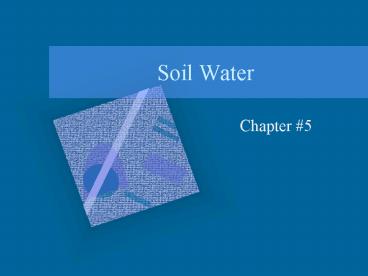Soil Water - PowerPoint PPT Presentation
1 / 21
Title:
Soil Water
Description:
There are 69,155,856 pounds of nitrogen in the air above an acre. ... a thin layer of water etc., the farther away from the soil particle you get, the ... – PowerPoint PPT presentation
Number of Views:26
Avg rating:3.0/5.0
Title: Soil Water
1
Soil Water
- Chapter 5
2
How much Nitrogen is in the Air above one acre?
- There are 69,155,856 pounds of nitrogen in the
air above an acre.
3
Why is water important to plants?
- it is a nutrient
- serves as a solvent for other nutrients
4
What are the water requirements for plants?
- plants use several hundred pounds of water for
each pound of dry matter produced
5
How does water enter the soil?
- through pores in the soil
- sandy soils have the largest pores, but are often
filled with other material - medium textured soils (loamy) have good water
entry properties - clays, pores swell shut when they get wet
6
What is Adhesion?
- it is the attraction of two different molecules
(water to soil)
7
What is Cohesion?
- it is the attraction of two similar molecules
(water to water)
8
What is the importance of adhesion and cohesion
in soils?
- water molecules are strongly attracted to soil
minerals and organic materials due to adhesion - water molecules are also strongly attracted to
each other due to cohesion - soil holds a thin layer of water, that layer
holds a thin layer of water etc., the farther
away from the soil particle you get, the looser
the water is held
9
What is the importance of adhesion and cohesion
in soils?
- -water then tends to move from wetter places to
drier places. Roots remove water, then water is
drawn from surrounding areas - in dry conditions, water moves slowly and only
fractions of an inch, thus roots must be well
distributed
10
How is soil water classified?
- 1) Hygroscopic Water is held so strongly by the
soil particles (adhesion), that it is not
available to the plants - 2) Capillary Water is held by cohesive forces
greater than gravity and is available to plants - 3) Gravitational Water is that water which cannot
be held against gravity - as water is pulled down through the soil,
nutrients are"leached" out of the soil (nitrogen)
11
What is Field Capacity?
- when the soil contains the maximum amount of
available water, the greatest amount of water it
can hold against gravity
12
What is Wilting Point?
- the soil has so little water, that plants can no
longer recover from wilting - roots can no longer take in water
13
What is Available Water?
- the amount of water between field capacity and
wilting point
14
What is Water Table?
- the level beneath the soil which the soil is
saturated with water - marshes develop where the water table is just
below the ground surface - if the water table is not too low, dryness tends
to correct itself through capillary movement
15
What affect does soil particle size have on its
water holding ability?
- the smaller the individual particles are, the
more surface area there is, thus it will hold
more water - consider a book compared to all of its pages
16
How is soil moisture measured?
- soil is weighed dry, then wet (expressed as a
percent of dry wt) - electrical conductivity
17
What factors determine the amount of soil
moisture?
- amount of snow, rain, irrigation
- rate which soil permits water entry
- water storage capacity of soil
- evaporation rate
- height of water table
- rate which water can move within the soil
- amount and type of vegetation
18
How can we increase the amount of avialable water
to the plant?
- Precipitation better utilize snow and rain by
keeping the water on the soil surface. - windbreaks
- keep snow in place (cover)
- strip cropping
- contour strips
- grassland farming
- Irrigation may not be practical
- Water entry reduce cultivation, green manures,
correct alkaline soils
19
How can we increase the amount of avialable water
to the plant?
- Storage capacity increase O.M. (manures)
- -Evaporation conservation tillage, shelter
belts, strip cropping - -Water movement in soil O.M.
- -Vegetative covering holds water
20
How much water do plants need?
- Transpiration Ratio pounds of water to produce a
pound of dry matter. - Corn 350 Wheat 500
- Potato 630 Grass Alfalfa 860
- It takes 4,533 gallons of water to produce enough
food for one person for 3 meals. (Thats
1,654,545 gallons per year) - It takes 10,000 gallons of water to make one
bushel of wheat - It takes 7.35" of rain to make a 20 bushel per
acre crop.
21
(No Transcript)































